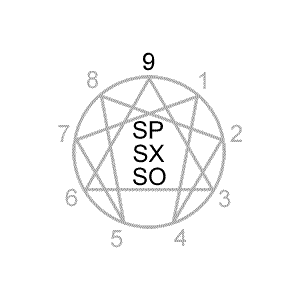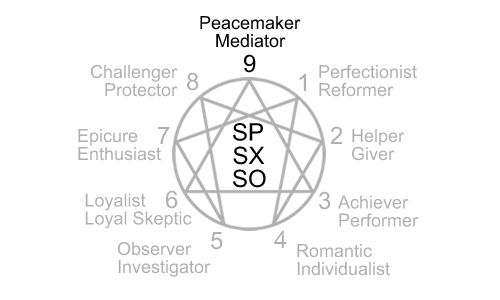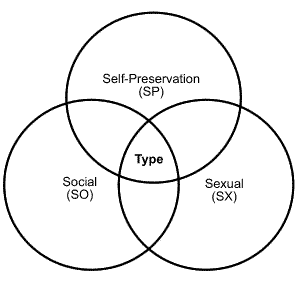Enneagram Type 9 Instinctual Subtypes: SP 9, SX 9, SO 9
The core focus of Enneagram type 9

We all have to live together, so we might as well live together happily.
- 14th Dalai Lama
Early in life we develop an initial belief about ourselves and a compensation for that self-belief.
-
Type 9 Initial Self-Belief: “I am not in unity as I am.”
Type 9 Compensation: "I must accommodate others' agenda and opinions in order to feel at ease and in harmony with them."
Over time this gets generalized beyond the self into a core focus that also shapes how we perceive and interact with the world at large.
-
Type 9 Core Focus: Harmony comes from getting along with others and falling into comfortable routines. This requires that I accommodate others by finding common ground and minimizing my own agenda when around others as well as finding comfort and peace of mind for myself.
Personality characteristics that might arise from the type 9 core focus include:
- Loses sight of own agenda in favor of the agenda of others
- Smooths over conflict in order to keep the peace and feel more at ease
- Has difficulty establishing goals and following through on them
- Struggles with inertia: getting going or changing course once underway
- Gets lost in peripheral activities that don't serve the primary objective
- Avoids creating separation from people by going along to get along
- Supresses anger which may surface as stubbornness or passive-aggressiveness
- Finds it difficult to prioritize because everything can seem equally important
- Numbs themself through comfort seeking and getting lost in routine
Enneagram type 9 instinctual subtypes

The Enneagram instincts are self-preservation (sp), sexual (sx), and social (so). The sexual (sx) instinct is also called the intimate or one-to-one instinct.
The instincts are traditionally used to define three instinctual subtypes or variations of a basic type (e.g., SP 9, SX 9, and SO 9). One of these three subtypes is called the counter-type because it can look different from the basic type.
Below are brief descriptions of the three type 9 instinctual subtypes.
SP 9 - Appetite, Collector: numbs oneself through eating, physical comfort, and routine activities; collects things and may have trouble deciding what to throw away; substitutes essential needs and wants with non-essentials.
SX 9 - Union, Fusion: sense of being comes from merging with significant others; can have difficulty individuating and standing on their own without reference to other; tendency to lose sight of own needs and desires in favor of other.
SO 9 - Participation (counter-type): participates in order to feel a part of the group; prioritizes group needs above their own and works hard toward those needs; fun-loving, sociable, congenial, doesn’t weigh others down with own woes.
While an individual may be identified with type 9 in general, that same individual may be more specifically identified with one of the three instinctual subtypes as well.
A more recent approach to using the instincts is instinctual variant stacking which can be used independent of Enneagram type.
What Enneagram authors say about type 9 instinctual subtypes

Below are Enneagram 9 subtype description samplings from some popular or well-known Enneagram authors. Click on the sources after the descriptions to further explore these interpretations.
-
In the average range, Self-Preservation Nines are the pleasant, easygoing Nines who do not ask much from life, preferring simple pleasures that are readily available.1
In the average range, Sexual Nines want to take on the energetic qualities of the other, often gravitating to aggressive types.1
In the average range, Social Nines are the Nines most interested in bringing people together and in making peace.1
-
Appetite in the Area of Self-preservation:Nines have a habit of replacing essential wishes with inessential substitutes, such as too much food, too much TV, too many novels, or elaborate hobby interests.3
Union in the One-to-One Relationship: For Nines, union is the desire to completely merge oneself with a mate. The preoccupation can also extend to an absorbing wish to unite with the divine.3
Participation in Social Groups: Nines are either totally aversive to joining groups, or they like to hang out with social groups, such as special activity clubs, and with friends.3
-
Self-Preservation Nines: Preoccupied with physical comfort, maintaining habits and satisfying appetites. Can have a love of the minimal and enjoy the repetition of known routines.5
Intimate Nines: Focused on an ideal of romantic union. Get lost in one relationship or in the yearning to have one. Can also deny their partner’s flaws and idealize them to stay in union.5
Social Nines: Tend to gravitate toward groups and then have conflicts about joining or staying apart. Can enjoy group energy and interests but may be also aware of the group‘s expectations.5
-
Type 9 Instinctual Subtypes by Beatrice Chestnut
Self-Preservation Nine: "Appetite"
Instead of feeling an ongoing connection to their feelings, desires, and power, they focus on merging with physical comforts and routine activities. They are practical, concrete people who focus on everyday things rather than abstractions.4Sexual Nine: "Fusion"
Expresses the passion of laziness by merging with the important people in their lives. They unconsciously take on the attitudes, opinions, and feelings of others, because it can feel too hard to stand on their own.4Social Nine: "Participation"
They act out laziness when connecting with their own inner life by working hard to be a part of the different groups in their lives. Fun-loving, sociable, and congenial characters, they can be workaholics, prioritizing the group‘s needs above their own.4
Sources
1Book: The Wisdom of the Enneagram; Website: The Enneagram Institute
2Book: The Enneagram; Website: The Narrative Enneagram
4Book: The Complete Enneagram; Website: Chestnut Paes Enneagram Academy
To learn more about the instincts click on a link below.
Enneagram Tests to Help Determine Instinct

There are two approaches to using the Enneagram personality instincts.
The instinctual subtypes describe three variations of each of the Enneagram types: a self-preservation (sp), sexual (sx), and social (so) subtype.
Instinctual variant stacking can be used with or without reference to Enneagram type by determining an individual's preferential order for the the three instincts (i.e., sp/sx, sx/sp, sp/so, so/sp, sx/so, or so/sx).
-
Instinctual Subtype Test
This test compares the three instinctual subtypes for a given type.
Use when you know your type and want to find your instinctual subtype for that type. -
Instinctual Variant Stacking Test
This test ranks the three instincts to determine your preferential order of the instincts.
Use when you want to know your instinctual variant stacking independent of type.
To learn more about Enneagram personality type 9 click here.
Click here for the Complete Guide to the Enneagram.
This free guide explains- the nine Enneagram personality types
- the many type variations within type
- where the types came from (origins and history)
- how the types use the Enneagram symbol
Click here for Enneagram tests.
These free tests help you find your- primary type
- candidate types
- preferred wing
- intinctual subtype
- instinctual variant stacking
- center types (gut, heart, and head)
- tri-center with wings